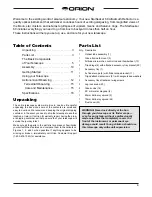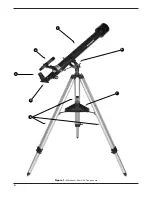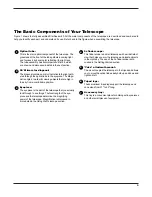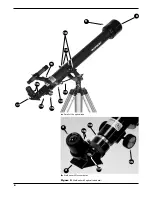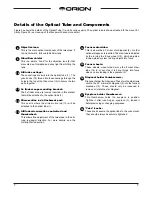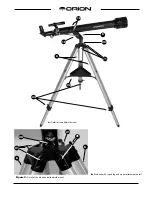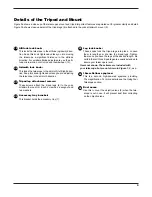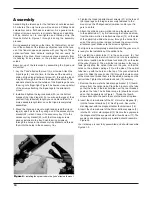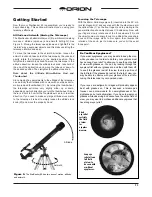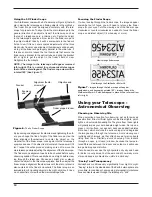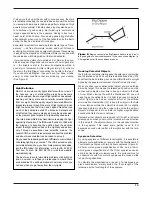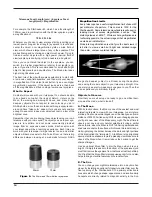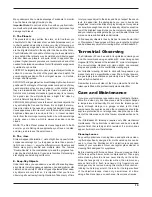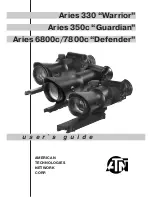
13
If, when you look up at the sky with your naked eyes, the stars
are twinkling noticeably, the seeing is bad and you will be limited
to viewing with low powers (bad seeing affects images at high
powers more severely). Planetary observing may also be poor.
In conditions of good seeing, star twinkling is minimal and
images appear steady in the eyepiece. Seeing is best over-
head, worst at the horizon. Also, seeing generally gets better
after midnight, when much of the heat absorbed by the Earth
during the day has radiated off into space.
Especially, important for observing faint objects is good “trans-
parency” — air free of moisture, smoke, and dust. All tend to
scatter light, which reduces an object’s brightness. Transparency
is judged by the magnitude of the faintest stars you can see with
the unaided eye (6th magnitude or fainter is desirable).
If you cannot see stars of magnitude 3.5 or dimmer then con-
ditions are poor. Magnitude is a measure of how bright a star
is — the brighter a star is, the lower its magnitude will be. A
good star to remember for this is Megrez (mag. 3.4), which is
the star in the “Big Dipper” connecting the handle to the “pan.”
If you cannot see Megrez, then you have fog, haze, clouds,
smog, or other conditions that are hindering your viewing.
(See Figure 8).
Tracking Celestial Objects
The Earth is constantly rotating about its polar axis, completing
one full rotation every 24 hours; this is what defines a “day”. We
do not feel the Earth rotating, but we can still tell that it is at night
by seeing the apparent movement of stars from east to west.
When you observe any astronomical object, you are watching
a moving target. This means the telescope’s position must be
continuously adjusted over time to keep an object in the field
of view. When viewing the with the StarSeeker 60, you will
need to give the optical tube (1) a light tug or push in azimuth
(left or right) as well as an occasional turn of the altitude
micro-motion thumbwheel (13) to keep the object in the field
of view. (Make certain the azimuth lock knob (20) is slightly
loosened before moving the scope in the azimuth position.)
Objects will appear to move faster at higher magnifications
because the field of view is narrower.
Remember that objects are reversed left to right in refractor
telescopes, so when you move the telescope in one direction
in the azimuth, the object will move in the opposite direction
in the eyepiece. This takes some getting used to, but
becomes second nature after a few nights out with the tele-
scope.
Eyepiece Selection
By using eyepieces of different focal lengths, it is possible to
attain many magnifications or powers with the StarSeeker 60.
Your telescope comes with two Kellner eyepieces (Figure 9):
a 25mm, which gives a magnification of 28x, and a 10mm,
which gives a magnification of 70x. Other eyepieces can be
used to achieve higher or lower powers. It is quite common for
an observer to own five or more eyepieces to access a wide
range of magnifications.
To calculate the magnification, or power, of a telescope-eye-
piece combination, simply divide the focal length of the
telescope by the focal length of the eyepiece.
Light Pollution
Most of us live where city lights interfere with our view of
the heavens. As our metropolitan areas have become
more developed, the scourge of light pollution has spread,
washing out many stars and nonstellar celestial objects
from our sight. Faint deep sky objects become difficult or
impossible to see through the murk of light pollution. Even
bright nebulas like the Orion and Lagoon Nebulas lose
much of their delicate detail. The Moon and planets are
not affected; they require steady air more than dark skies,
so they remain good targets for city-dwelling observers.
The International Dark-Sky Association is waging the fight
against light pollution. The IDSA was founded in 1988 with
the mission of educating the public about the adverse
impact that light pollution has on the night sky and astron-
omy. Through educational and scientific means, the
nonprofit IDA works to raise awareness about the problem
and about measures that can be taken to solve it.
Do you need help dealing with local officials to control street
or building lighting in your area? The IDA’s extensive sup-
port materials can show you how. Help preserve dark skies,
join the IDA today! For information, write to IDA, 3225 N.
First Ave., Tuscon, AZ 85719-2103 or visit their website:
www.darksky.org.
The best way to avoid immediate problems with light pol-
lution, however, is to take you telescope to where there
are dark skies. You will be amazed at how many stars you
can see when you get away from the city lights.
2.4
1.7
3.4
2.4
4.9
1.9
1.9
2.5
Figure 8.
Megrez connects the Big Dipper’s handle to it's “pan”. It
is a good guide to how conditions are. If you can not see Megrez (a
3.4 magnitude star) then conditions are poor.



